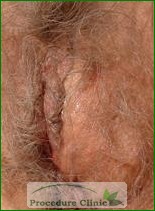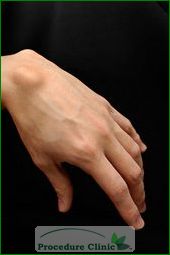Cyst
Epidermoid cyst
Epidermoid cysts are small bumps that develop just beneath the skin on your face, neck, trunk and sometimes your genital area. They are slow-growing and often painless. Although many people refer to epidermoid cysts as sebaceous cysts, true sebaceous cysts are much less common than epidermoid cysts are.
Epidermoid cysts are almost always noncancerous, but in rare cases, they can give rise to skin cancers. Because this occurs so seldom, epidermoid cysts usually aren't biopsied unless they have unusual characteristics that suggest a more serious problem.
Epidermoid cysts:
- Are round cysts or small bumps that are easy to move with your fingers?
- Are usually white or yellow, though people with darker skin may have pigmented cysts?
- Range in size from less than 1/4 inch to nearly 2 inches (a few millimeters to 5 centimeters) in diameter
- Occur on nearly any part of your body, including your fingernails, but are found most often on your face, trunk and neck.
Sometimes an epidermoid cyst has a central opening — the remnant of a hair follicle from which the cyst originally formed — that's plugged by a tiny blackhead. You may be able to squeeze out a thick, cheesy material through this opening, but because of the risk of infection and scarring, it's best to leave this to your physician.
Signs and symptoms of infection, which can occasionally occur, include thick, yellow material draining from the cyst that may have a foul odor and redness, swelling and tenderness around the cyst
Causes
The surface of your skin (epidermis) is made up of an extremely thin, protective layer of cells that your body continuously sheds. Most epidermoid cysts form when these surface cells, instead of exfoliating normally, move deeper into your skin and multiply. Most often, this occurs in areas where there are small hair follicles and larger oil glands (sebaceous glands), such as your face, neck, upper back and groin.
The epidermal cells form the walls of the cyst, and then secrete the protein keratin into the interior. The keratin is the thick yellow substance that sometimes drains from the cyst.
Complications
In rare cases, epidermoid cysts can give rise to basal and squamous cell skin cancers. Because this occurs so seldom, epidermoid cysts usually aren't biopsied unless they're solid, immobile, infected or have other unusual characteristics that suggest a more serious problem.
Besides cancer, other complications include:
- Inflammation. Epidermoid cysts can become tender and swollen, even if they're not infected. Inflamed cysts are difficult to remove, and your doctor is likely to postpone treating them until the inflammation subsides.
- Rupture. A ruptured cyst often leads to a boil-like abscess that requires prompt treatment.
- Infection. An epidermoid cyst can become infected spontaneously or after a rupture.
Treatments and drugs
Small cysts that don't cause cosmetic or functional problems are usually left alone. When a cyst is inflamed, gets bigger, ruptured or infected, these treatment options exist:
Incision and drainage: your doctor makes a small cut in the cyst and expresses the contents. Although incision and drainage is relatively quick and easy, cysts often recur after this treatment.
Total excision: The surgical excision removes the entire cyst and so prevents recurrence. Excision is most effective when the cyst isn't inflamed. Your doctor may recommend first treating the inflammation with antibiotics, steroids, or incision and drainage and then waiting to perform excision for four to six weeks after inflammation resolves. Total excision requires sutures. Your doctor will remove sutures in your face within a week or so of total cyst excision, and will remove sutures elsewhere in your body within a week.
Minimal excision: Some doctors prefer this technique because it removes the whole cyst wall but causes minimal if any scarring. During the procedure, your doctor makes a tiny incision in the cyst, expresses the contents, and then removes the cyst wall through the incision. The small wound is usually left to heal naturally.
Bartholin’s Cyst
The Bartholin's glands are located on each side of the vaginal opening. These glands secrete fluid that helps lubricate the vagina. Sometimes the openings of these glands become obstructed, causing fluid to back up into the gland. The result is relatively painless swelling called a Bartholin cyst. At times, the fluid within the cyst may become infected, resulting in pus surrounded by inflamed tissue (abscess). A cyst or abscess typically occurs on only one side of the vaginal opening.
A Bartholin cyst or abscess is common. Treatment of a Bartholin cyst depends on the size of the cyst, the pain and whether the cyst is infected. Sometimes home treatment is all you need. In other cases, surgical drainage of the Bartholin cyst is necessary. If an infection occurs, antibiotics may be helpful to treat the infected Bartholin cyst.
If the cyst remains small and no infection occurs, you may not notice it. If it grows, you might feel the presence of a lump or mass near your vaginal opening. Although a cyst is usually painless, it can be tender.
If the cyst becomes infected — a full-blown infection can occur in a matter of days — you may experience the following signs and symptoms:
- A tender or painful lump near the vaginal opening
- Discomfort while walking or sitting
- Pain during intercourse
- Fever
Causes
Experts believe that the cause of a Bartholin cyst is a backup of fluid. Fluid may accumulate when the opening of the gland (duct) becomes obstructed, perhaps by the growth of a flap of skin or because of infection.
A cyst can become infected, forming an abscess. A number of bacteria may cause the infection, including common bacteria, such as Escherichia coli (E. coli), as well as bacteria that cause sexually transmitted diseases such as gonorrhea and chlamydia.
Treatments and drugs
The treatment of a Bartholin cyst depends on the size of the cyst, the amount of discomfort it causes and whether it's infected, resulting in an abscess. Here are some of the treatment options your doctor may recommend:
Sitz baths: Sometimes, soaking in a tub filled with a few inches of warm water (sitz bath) several times a day for three or four days helps a small, infected cyst to rupture and drain on its own.
Surgical drainage: A cyst that's infected or very large generally requires drainage by a doctor. Drainage of a cyst can be done in your doctor's office under local anesthesia, but in some cases, you and your doctor may opt for general sedation, if that makes you more comfortable. To do the drainage procedure, your doctor makes a small incision in the cyst to allow it to drain. Then he or she places a small rubber tube (catheter) in the incision. The catheter stays in place for up to six weeks to keep the opening from closing and to allow complete drainage. After that, the catheter may fall out on its own or be removed and the incision heals completely.

Antibiotics: If the cyst is infected, or if testing reveals a sexually transmitted disease, your doctor may prescribe antibiotics to ensure that the bacteria causing the infection are destroyed. But if the abscess is drained properly, you may not need antibiotics.
Marsupialization: If cysts recur or are bothersome to you, your doctor may perform a procedure called marsupialization. This method is usually effective in preventing recurrences. It's similar to the surgical drainage procedure, only your doctor places stitches on each side of the incision to create a permanent opening, less than 1/4 inch (about 5 millimeters) long. Your doctor may insert a catheter to promote draining for a few days to prevent recurrence. This procedure can be done in your doctor's office but, depending on the complexity of the cyst, is often done in an operating room in the hospital under general anesthesia. Since marsupialization isn't recommended when an active infection is present, your doctor will likely want to drain the abscess first and get rid of the infection, then perform the marsupialization.
If you have persistent recurrences and none of these procedures is successful, your doctor may recommend removal of the Bartholin's gland, but this is rarely necessary. Some doctors are using laser therapy to treat Bartholin cysts, but this type of treatment isn't widely available and is more expensive than other surgical treatments.
Lifestyle and home remedies
Daily soaking in warm water, several times a day, may be adequate to resolve an infected Bartholin cyst or abscess.
After surgical procedures to treat an infected cyst or abscess, soaking in warm water is particularly important. Sitz baths help to keep the area clean, ease discomfort and promote effective drainage of the cyst. Pain relievers also may be helpful. If you have a catheter in place, you may resume your normal activities, including sex, depending on your level of comfort.
Ganglion Cyst
Ganglion cysts are noncancerous fluid-filled lumps (cysts) that most commonly develop along the tendons or joints of your wrists or hands. They may also appear in your feet. A ganglion cyst may develop suddenly or gradually over time. The exact cause is unknown.
In many cases, ganglion cysts will cause you no pain and require no treatment. Often, they go away on their own. When you do need treatment for a ganglion cyst — due to pain or interference with joint movement or for cosmetic concerns — it usually consists of removing the fluid from the ganglion cyst or surgically removing the cyst.
Ganglion cysts generally are:
- Raised lumps near your wrist or finger joints
- Round, firm and smooth
- Fluid-filled, as evidenced by shining a light through the cyst (transillumination)
- Variable in size depending on your activity level, becoming larger when you use the affected joint and growing smaller when you're at rest
- Painless, although in some cases the cysts may put pressure on the nerves near the joint, which can cause pain, weakness or numbness.
In some cases, the telltale lump that usually indicates a ganglion cyst isn't visible. Often the only indication of these smaller, "hidden" ganglion cysts (occult ganglions) is pain. These occult cysts can be seen only with ultrasound or MRI.
Causes

It's not clear what causes a ganglion cyst to develop. It grows out of a joint, similar to a balloon on a stalk, and seems to occur when the tissue that surrounds a joint or a tendon bulges out of place. Inside the cyst is a thick fluid similar to that found in joints or around tendons.
Treatments and drugs
Small ganglion cysts are often harmless and painless, requiring no treatment. In fact, in many cases, doctors recommend a watch-and-wait approach before exploring treatment options. However, if the ganglion cyst is causing pain or it's interfering with joint movement, your doctor may recommend one of several treatment options.
Immobilization: Because activity can make the ganglion cyst grow larger, your doctor may recommend wearing a wrist brace or splint to immobilize the area. This helps your hand and wrist to rest, which may help shrink the cyst. As the cyst shrinks, it may release the pressure on your nerves, relieving pain.
Aspiration: your doctor drains the fluid from the cyst. To do so, your doctor applies a local anesthetic to the area above the cyst. Then, he or she punctures the cyst with a needle and removes the fluid from the base of the cyst with a syringe. Your doctor may recommend a steroid injection into the empty cyst after aspiration. This procedure can be done right in your doctor's office.
After aspiration, as many as 60 percent of ganglion cysts may recur. If the cyst recurs, aspiration can be repeated. However, in some cases your doctor may recommend surgery to remove the cyst.
Surgery: If you have significant pain or difficulty with joint movement, or if other treatments aren't working, your doctor may recommend surgery to remove the ganglion cyst. In most cases, doctors perform the surgery on an outpatient basis, which means you'll go home the same day as the operation.
During surgery
- Typically, a local or regional anesthetic is used to numb the affected area.
- The surgeon then makes an incision in the skin overlying the ganglion cyst. The size of the incision depends on the size of the cyst.
- The surgeon removes the cyst and the stalk that attaches it to the joint or tendon, along with a small portion of the surrounding tissue in most cases.
- Then the surgeon will stitch and bandage the affected area.
After surgery
- Keep the affected limb elevated for up to 48 hours to help reduce swelling. You may experience discomfort, swelling and tenderness for two to six weeks.
- Your doctor may recommend analgesics, such as acetaminophen (Tylenol, others), or nonsteroidal anti-inflammatory drugs (NSAIDs), such as ibuprofen (Advil, Motrin, others) or naproxen (Aleve, Naprosyn, others), for pain relief.
- Change your bandages (dressings) as directed.
- Depending on the location of the cyst, your doctor may recommend temporarily wearing a splint or brace to help minimize postoperative pain. In most cases, however, moving the affected area soon after surgery is recommended.
- As the incision heals, it's important to watch for signs of infection, including redness, swelling or discharge.
- Usually, physical therapy is not necessary after ganglion cyst removal. But if you have new problems with joint stiffness, therapy may help you regain strength in your hand, wrist or foot.
Unfortunately, there's no guarantee that a ganglion cyst won't recur, even after surgery. And as with all surgeries, there are risks to be considered. Though rare, injury to nerves, blood vessels or tendons may occur. These could result in weakness, numbness or restricted motion. Your doctor can help you decide the best treatment for you.
Pilonidal Cyst

A pilonidal cyst is an abnormal pocket originating in the skin that usually contains hair, skin debris and other abnormal tissue. A pilonidal cyst is almost always located near the tailbone at the top of the cleft of the buttocks. The term "pilonidal" comes from the Latin words for hair ("pilus") and nest ("nidus").
Pilonidal cysts affect men more often and most commonly occur in young adults.
A pilonidal cyst may remain harmless. If it becomes infected, however, it will cause pain, inflammation and usually drainage of fluids.
A pilonidal cyst may cause no noticeable symptoms (asymptomatic). The only sign of its presence may be a small pit on the surface of the skin. When it's infected, a pilonidal cyst becomes a swollen mass (abscess).
Causes
There is some disagreement about what causes pilonidal cysts. Most pilonidal cysts appear to be caused by loose hairs that penetrate the skin. Friction and pressure — skin rubbing against skin, tight clothing, bicycling, long periods of sitting or similar factors — force the hair down into skin. Responding to the hair as a foreign substance, the body creates a cyst around the hair.
This explanation accounts for rare cases of pilonidal cysts that occur in parts of the body other than near the tailbone. For example, barbers, dog groomers and sheep shearers have developed pilonidal cysts in the skin between fingers.
Another possible explanation is that normal stretching or motion of deep layers of skin causes the enlargement and rupture of a hair follicle, the structure from which a hair grows. A cyst then forms around the ruptured follicle.
Some children are born with a small indentation in the skin (sacral dimple) near the top of the cleft of the buttocks. Rarely, a sacral dimple may become infected, essentially forming a pilonidal abscess.
Treatments and drugs
The initial surgical drainage for an infected pilonidal cyst, or pilonidal abscess, is usually a procedure performed by your primary care doctor or a surgeon. You're given a local anesthetic to numb the area before your doctor opens the abscess, drains the fluids, and removes hair and other debris. The wound is packed with dressing so that it can heal from the inside out. For up to 60 percent of people with an infected pilonidal cyst, this treatment is effective and no further treatment is needed.
A surgical excision is necessary if you have a recurring infected pilonidal cyst or if one or more sinus tracts are present. A surgeon will expose the cysts and all sinus tracts in order to clean out hairs, pus and other debris. The preferred surgical procedures generally fall into two categories:
- Open wound. The surgical wound is left open and packed with dressing to allow it to heal from the inside out. This process results in a longer healing time but usually a lower risk of a recurring pilonidal cyst infection.
- Closed wound. After cleaning out the cyst and sinus tracts, the surgeon stitches the wound closed. The healing time is shorter with these procedures, but there is a greater risk of recurrence. To improve healing time and lower the risk of recurrence, the surgeon may make the incision off to one side and create a flap of skin. Therefore, when he or she stitches the wound, it is not in the cleft of the buttocks, where healing is particularly difficult.
Wound care is extremely important after surgery. Your doctor or nurse will give you detailed instructions on how to change dressings, what to expect of a normal healing process and when to call the doctor. Postoperative care will also include shaving around the surgical site to prevent hairs from entering the wound.

